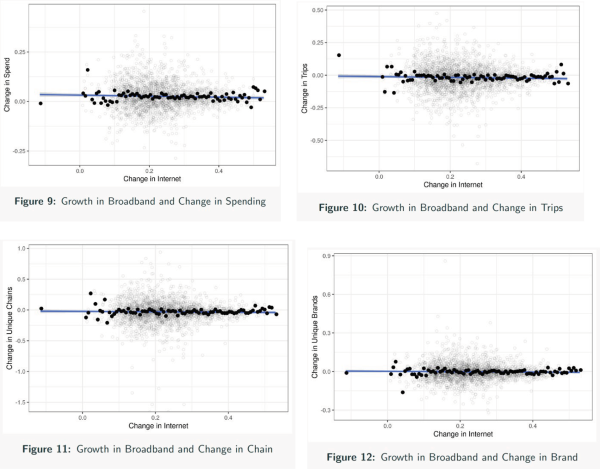
How broadband is reshaping the retail industry and what it means for the future
06/15/23The introduction of broadband internet has significantly influenced the retail sector in the United States. It has altered how consumers gather information, buy products, and interact with retailers. One of the most notable changes brought about by broadband internet is the ease of information access for consumers.
Before the broadband era, consumers relied heavily on physical stores and sales associates for product information. However, the high-speed internet era has introduced a new paradigm where consumers with broadband internet can seamlessly access product reviews, compare prices across multiple retailers, and even make purchases online without leaving their homes.
E-commerce in the retail sector
Broadband internet is reshaping the retail landscape through e-commerce platforms as well. Online marketplaces like Amazon, eBay, and Walmart have made it easier for retailers to sell their products online. These platforms provide various tools and services to assist retailers in reaching new customers and managing their online businesses.
The emergence of social media platforms has also enabled retailers to connect with their customers in new ways, potentially building stronger relationships with them and enhancing overall customer service. Retailers can share information about new products, promotions, and sales, and engage with customers directly, potentially increasing a loyal retail customer base.
Analytics in the retail sector
In addition to these changes, broadband internet has made it possible for retailers to collect and analyze more data about their customers. Retailers can use data analytics to understand consumer buying habits and preferences, which allows them to make more informed decisions about which products to sell and how to market them. Analytics in the consumer retail sector have also led to increased personalized marketing, as retailers can use data to target specific customers with tailored advertising.
Has broadband affected consumer behavior?
Given these many changes, many believe the retail apocalypse is upon us. Major news sources have been suggesting that the end is near for brick-and-mortar retailers — with Bed, Bath & Beyond news crossing many media outlets. But has broadband affected consumer behavior?
In my research, I aimed to determine whether those headlines held any merit. Here’s what I found:
- From 2006-16, there was a notable growth in broadband users. On average, counties experienced 20% more household connectivity. However, during that same period, consumer spending remained about the same.
- On average, households were spending about $7,300 per year in 2006, and by 2016, that number rose slightly to over $7,600 — a number in line with inflation.
- Meanwhile, the average number of trips to the store decreased from 3.4 to 3.1 per week. Additionally, consumers shopped at slightly fewer chains, from 24 in 2006 to 21 in 2018. Interestingly, while the number of brands on the market increased during this period, the number of brands purchased per household decreased. Because more brands are available, households can find more tailored brands to fit their lifestyle and needs.
I use several different measures of consumer behavior: spending, trips to the store, chains, and brand choice. The change was relatively small when I examined broadband’s effect on consumer behavior. Moreover, broadband did not affect pricing, price dispersion, or price elasticity.

So, what is the retail apocalypse, and is it real?
The “retail apocalypse” is a term used to describe the perceived widespread closures of brick-and-mortar retail stores in recent years, often attributed to the rise of e-commerce. Some retailers have indeed struggled and closed stores or gone out of business. However, it might be an overgeneralization to say that a retail apocalypse is happening.
Some brick-and-mortar retailers are thriving
Various factors have contributed to the challenges faced by brick-and-mortar retailers, including the growth of e-commerce and the rise of direct-to-consumer brands.
However, not all retailers are equally affected by these factors; some are thriving in the current retail landscape.
Investing in an omnichannel strategy
Retailers that have invested in omnichannel strategies, such as offering online shopping options and integrating digital experiences with physical stores, have reportedly seen tremendous success. Additionally, retailers that provide unique experiences or products not replicable online have also found success.
Four examples of retailers that have adapted to the changing retail landscape, include:
- Target — Target has been successful in recent years due in part to its omnichannel strategy that integrates its physical stores with its online platform. In 2020, Target’s total revenue was $93.6 billion, up from $77.1 billion in 2019.
- Best Buy — While many electronics retailers have struggled in the face of competition from e-commerce, Best Buy has been able to adapt and remain successful. In 2020, the company’s total revenue was $47.3 billion, up from $43.6 billion in 2019.
- Ulta Beauty — As a beauty retailer that offers both online and in-store shopping experiences, Ulta Beauty has been successful in recent years. In 2020, the company’s total revenue was $7.4 billion, up from $7.0 billion in 2019.
- Walmart —Walmart has been able to adapt and compete with e-commerce giants like Amazon. In 2020, Walmart’s e-commerce sales grew by 79%, and the company’s total revenue for the year was $559 billion.
Retailers searching for ways to adapt and thrive
While brick-and-mortar retailers face challenges, it is essential to acknowledge that not all retailers are equally affected and that some are finding ways to adapt and thrive. The idea of a “retail apocalypse” may oversimplify the complex and nuanced reality of the retail industry.
What’s in store for retailers
While the impact of broadband internet on the retail sector appears to be largely positive, it is essential to note that the digital divide is still a significant issue. In the U.S, 40% of people still need access to high-speed internet (25 Mbps or higher).
This means there are still many areas where consumers cannot take advantage of the benefits of online shopping and e-commerce. Policymakers must address this issue, as it has significant implications for consumers and businesses.
Creating a seamless user experience
As more people gain access to high-speed internet, e-commerce will continue to grow and evolve. And so will brick-and-mortar retailers. Brick-and-mortar retailers will likely continue to compete and evolve to avoid the same fate as Sears or Bed, Bath, and Beyond.
Retailers should continue to find ways to create a seamless experience across all channels, including physical stores and online marketplaces. This requires a significant investment in technology and infrastructure, which can be difficult for smaller retailers.
Retail customer information security
Another challenge is the need to protect customer data and maintain cybersecurity. Retailers — whether online or in-store — must ensure customer information is secure.
Protecting data requires ongoing investment in:
- Cybersecurity measures
- Employee training
- Regulation compliance
Retailers need to evolve
As I continue my research, one thing seems clear: the retail sector is alive and well and, in many cases, possibly thanks to broadband. Nothing has replaced physical stores because of the tactile and communal experiences they provide. However, they will need to evolve. Moving forward, it will be critical for retailers to adapt their offerings to a more holistic buying experience to provide a consistent experience across all channels.
Take this knowledge to the next level
If you are interested in exploring this topic further or learning directly from Assistant Professor Uyen Tran, consider applying to Thunderbird School of Global Management’s online Master of Leadership and Management degree program. Once enrolled, students may enroll in courses such as Data Analytics and Digital Transformation in a Global World, taught by Professor Tran, and others including: Navigating Global and Regional Business Environments, Strategy in a Competitive World, Global Leadership and Personal Development, Customer Experience and Digital Marketing in a Global World, Global Entrepreneurship and Sustainable Business, and more.





